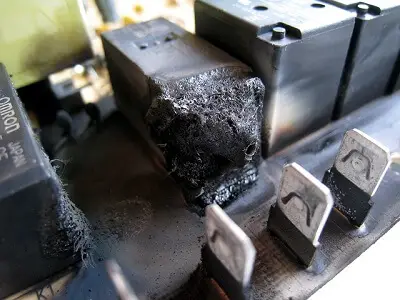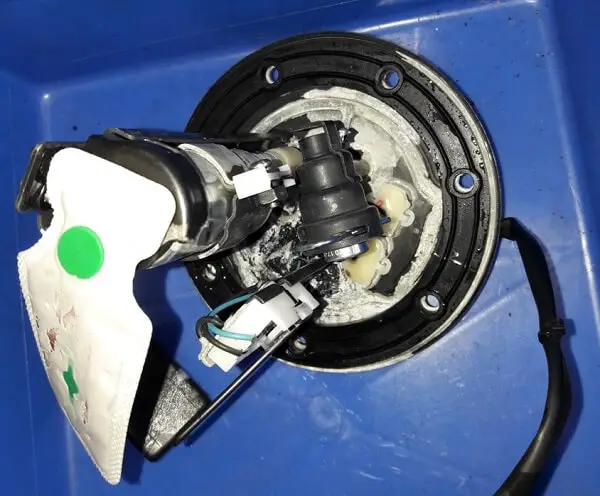The fuel pump is one of the important components of the vehicle that keeps the engine running. When the car is sitting for a long time and not being used for couple of months and if you try taking such vehicle out, you may encounter the issue of vehicle starting problem.
If the vehicle starts then the engine may be stammering or misfiring, poor throttle response, vehicle running and stopping intermittently.
In such cases, you may experience this issue just over some distance of running immediately after vehicle start, but after covering certain mileage you may feel that the engine is performing smoothly as expected. This may be due to either the fuel pump not priming at all or improper priming might be the case.
The fuel pump not priming problem mainly occurs due to issues in one or more parts like a bad fuel pump relay, bad fuel pump ground, bad fuel pump fuse, bad fuel pump fuse, bad crank or cam position sensor, faulty fuel pump, faulty ECM, no power to injectors, loose wiring connection, poor battery supply voltage, immobilizer switching off the fuel pump.
If you are also facing similar problems, then you are at the right place. Here in this article, we will talk about the reasons for fuel pumps not priming and solutions to fix it.
Table Of Contents
What Is Fuel Pump Priming?
The fuel pump is the component that ensures that the fuel is pumped from the fuel tank with the required flow rate and pressure and reaches the engine cylinder head for combustion that keeps the engine alive.
If you are experiencing a fuel pump not priming issue in your vehicle, then you shall first get familiar with how the fuel pump priming works.
Before you start cranking the engine, the pressurized fuel has to be available at the inlet of fuel injectors to make sure that the fuel is atomized and converted into a combustible mixture for engine cylinder firing.
Many times people notice that there is not enough pressure in the fuel supply line getting connected to the engine. Hence the engine cylinders don’t fire upon starting the vehicle.
This will force you to crank the engine a few times to prime the fuel pump to fill the fuel supply line with pressurized fuel to fire the engine.
In modern vehicles having an FI Fuel injection system, the fuel tank has an in-tank electric fuel pump that has a self-priming feature that ensures that the fuel pump runs for a few seconds (say 2 to 3 seconds) once you turn the key to ignition ON mode and this operation is controlled by ECM (Electronic control module)
In ignition ON mode, the vehicle ECM triggers and grounds the fuel pump relay for 3 seconds, which will ensure power supply to the fuel pump to run and generate enough fuel pressure in the fuel supply hose to prepare the fuel system for engine running. This is called fuel pump priming.
If you could listen to a mild humming sound coming from beneath the second seat row of your vehicle, then it means that the fuel pump is priming. If not, then probably the fuel pump priming is not happening.
If you have kept the key in the ignition ON position, then after 3 seconds the fuel pump priming stops. This is because, since the engine is not cranked, the crank position sensor would indicate ECM to deactivate the fuel pump relay, so the fuel pump stops running.
This is programmed in the ECM. Apparently, we don’t want the fuel pump to run if the engine is not cranked. The ECM won’t turn ON the fuel pump again until it receives RPM signals from the crank position sensor or you turn the ignition OFF and back ON again.
During fuel pump priming, apart from the fuel supply line is pressurized, the air trapped inside the pump is expelled out into the fuel tank for proper fuel pumping operation.
Fuel Pump Not Priming? Reasons And Solutions To Fix It!
People often come across the problem with the fuel supply system, over some mileage of vehicle due to the durability life limitation of the fuel system components, especially the fuel pump which has rotating parts that keeps the engine firing and vehicle rolling.
Before doing iteration testing, it is better to confirm that the engine performs well if the fuel pump is functioning correctly. This can be checked by spraying starting liquid on the intake manifold & see whether the engine starts.
If there is no problem with the engine components, then in most cases the engine will start and run for a second or two, then shut down once the starting fluid is consumed. Otherwise, you may need to look into engine components for troubleshooting the problem.
So there are several such techniques that we will discuss in this article. Below are the certain reasons for the fuel pump not priming issue. You may check out each one and identify which one is applicable in your case after careful analysis of each component.
Bad fuel pump relay

In 2 out of 5 cases, it is the fuel pump relay that turns out to be the culprit for the issue of the fuel pump not priming. As you turn on the ignition key, look for the clicking sound from the main and fuel pump relay and 3 seconds later you shall hear another clicking sound indicating that the fuel pump relay is deactivated by the ECM.
If it doesn’t, then you have the faulty fuel pump relay and the issue can be fixed only after replacing the fuel pump relay with a new one. Sometimes the issue could be as simple as the fuel pump relay is fitted loose on the block and this loose connection will make the fuel pump, not prime.
Fuel pump relay usually has got 4 pins namely 85, 86, 87, and 30 which represent ECU ground, input voltage supply, power supply to the fuel pump, and hot wire (battery voltage) respectively in that sequence.
If there is an issue in the fuel pump relay, then there will not be voltage supply to the fuel pump (87) and the fuel pump not priming issue will be noticed.
This can be checked by connecting a multimeter. Set the multimeter to read voltage(20V) and connect the probes of the multimeter to 87 and 30 pins, then connect the pins 85 and 86 to battery negative (ground) and positive terminals.
If you are looking for short term fix for the problem, you may bypass the fuel pump relay till you reach your garage to work on it.
If the multimeter reads 12V then, then the fuel pump relay is functioning correctly. If not, then the fuel pump relay is not grounded and activated by the ECU as expected. You may need to replace the fuel pump relay to fix it.
Bad fuel pump ground
Often fuel pump priming issue is due to improper electrical wiring and connections. If the grounding of the fuel pump has gone bad, then there will be no current supply to the fuel pump and it won’t prime.
To confirm the problem, connect the battery positive terminal directly to the fuel pump, if the pump runs fine then the ground is ok. Otherwise, the fuel pump ground is bad.
Bad fuel pump fuse
Have you checked the condition of the fuel pump fuse? It is most obvious that if the fuel pump fuse is blown out, then there will not be any power supply to the fuel pump.
So, it is essential to do check the fuse to troubleshoot the fuel pump issue. If you notice that the fuel pump fuse keeps blowing, then it is the case of failing fuel pump, since the bad pump would draw more current to overcome the internal resistance and ends up blowing the fuel pump fuse.
Hence the fuel pump won’t prime, but often people ignore simple problems of fuel pump fuse and look for more complex vehicle components while troubleshooting the fuel pump priming issue. The issue can be fixed only by replacing the fuel pump fuse with new one.
You may like to refer to this article for detail reading: “Fuel Pump Fuse Keeps Blowing? 9 Causes And Solution To Fix It!”
Bad fuel pump check valve
The check valve is the part in the fuel pump module which ensures that the fuel pressure is maintained in the fuel supply hose even when the vehicle is not running. The check valve does this by blocking the return flow of fuel back to the fuel tank through the main supply line.
But if the check valve is a faulty one, whatever pressure that the fuel pump develops to maintain pressure in the fuel supply line goes in vain and the pressure drops in the outlet line and you may think that the fuel pump is not priming.
In such scenario, you may need to crank the engine a few times before the engine starts cranking when the fuel pressure is developed in the supply line.
Faulty fuel pump
The fuel pump after usage over a while will undergo wear and tear of internal parts. The impeller is one such part when gets worn out, it creates more clearance between the inlet and outlet plates.
This reduces the suction vacuum created by the pump and so the fuel pump sucks less or no fuel from the fuel tank and the fuel pump not priming issue is noticed down the lane.
Also in almost all fuel pumps, a vapor jet hole, usually called a recirculation port is provided to expel the air trapped inside the fuel pump.
But when this port gets clogged, the air trapped remains inside and the fuel pump won’t prime and pump the fuel since the presence of compressible air would not allow to create required suction pressure and pressurize the fuel.
If you have not used the car for a long time, the fuel pump would go bad from sitting, since the fuel inside fuel tank would get oxidized and would jam the fuel pump.
If you are thinking that the pump is not priming simply because you don’t get that typical buzzing sound that gets created while the fuel pump primes, then check the fuel pressure in the fuel supply line with the help of a pressure gauge.
If the pressure gauge is in the range between 35 to 50 psi, then it is performing ok. If not, then the fuel pump is bad hence it won’t prime unless the fuel pump is replaced with a new one.
Bad crank or cam position sensor
As discussed earlier, it is the crank position sensor that sends a feedback signal to the ECU that the engine is cranking, so the ECU ensures continuous power supply to the fuel pump by grounding the fuel pump relay and keeps the fuel pump running.
But if the crank or cam position sensor goes bad, it sends faulty signals to the ECU so the fuel pump not priming issue will be observed unless the problem is fixed by replacing the bad crank position sensor or cam position sensor with a new one.
Faulty ECM
It is the ECM that grounds the fuel pump relay to activate it. Once the fuel pump relay is activated, the load side switch contact (30 and 87) is closed and the power is supplied to the fuel pump for priming.
In the event of faulty ECM, it won’t send pulse signals to the pump relay. Hence you may notice that the fuel pump is not priming unless the ECM issue is fixed.
No power to injectors
Have you checked the voltage supply to the injectors? When the ignition key is turned ON, the injector shall get the 12 V power feed to fire.
No power supply to the injectors means that the engine won’t start. Often the no power feed to the injectors is mistaken as fuel pump not priming.
Article you may like to read: Fuel Injector Vs Fuel Pump?
Loose wiring connection
Do some continuity check in the fuel pump wiring harness to confirm that the non-priming fuel pump is not due to the loose wiring connections.
Set the multimeter to read continuity and connect the leads across the fuel pump terminals. If there is an issue in wiring continuity, then the multimeter won’t produce a continuous beeping sound.
Also, check the continuity of the ground signal wire from the ECM terminal to the fuel pump relay.
In many cases, there must be some discontinuity in these wiring harnesses to make the fuel pump not priming.
Ensure that all the electrical connections are good and clean for optimal performance, if not replace the same.
While replacing the fuel pump or electrical connectors and wiring, you need to confirm the fuel pump wires color codes to avoid possible wrong wiring. Otherwise, the fuel pump won’t prime and the vehicle won’t start due to no power supply to the fuel pump.
Poor battery supply voltage
If the battery is nearing its end of life, then there could be either no or less voltage supply to the fuel pump. Take out a multimeter and check the voltage across the fuel pump terminal while keeping the ignition key ON.
If no power, then check the fuel pump relay and also confirm whether the fuel pump ground is good.
If the power is available and the multimeter reads less than 12 V, then the battery may not be supplying enough current for fuel pump operation. The fuel pump priming issue will not get fixed unless the battery is replaced with a new one.
Immobilizer switching off the fuel pump
Are you getting the error of immobilizer activated on your dash, then probably it will switch off the power supply to the fuel pump and won’t allow it to prime.
You may need to inspect the reason for the activation of the anti-theft device and fix it or you may need to jump the immobilizer directly to the fuel pump to bypass the anti-theft device temporarily.
Steps To Troubleshoot Fuel Pump Not Priming Issue
- Connect a test light to the fuel pump positive terminal of the connector and the ground.
- Turn the ignition key ON and leave the key in the ON position. The test light shall flash ON then OFF,
- If the test light flashes temporarily, it means that the ECM has grounded the fuel pump relay to prime the fuel pump as expected. (proceed to step 3).
- If the test light does not flash, it means that the fuel pump relay is not activated by the ECM. The issue maybe with the relay or ECM or one of the relay circuits.
- If the test light is continuously ON, then it means there is a wiring short in between the ECM and the fuel pump relay, so there is a continuous grounding of the fuel pump relay and hence the continuous power to the fuel pump. So the fuel pump would be running continuously with key on.
- When you start the vehicle by cranking the engine,
- The test light shall be constantly ON and it shall not flash or switch off indicating that the ECM is continuously grounding the fuel pump relay as expected.
- But if the test light flashes momentarily, then the ECM may not be receiving a signal from the crankshaft position sensor. It may mean that the crankshaft position sensor is shorted and must be replaced.
- If the test light did not flash during cranking, then inspect the crankshaft position sensor connector and look for a loose connection. The problem may be either with the crankshaft position sensor/camshaft position sensor or ECM ground circuit to fuel pump relay.
Conclusion
When you do not hear the buzzing sound of fuel pump priming and the vehicle is creating starting and running problems then it’s time to troubleshoot the fuel pump and its related electrical circuit and components.
When you perform the confirmatory tests as discussed above, then you should get a confirmation for both the temporary voltage, indicating that the fuel pump is priming as well as the constant voltage representing that the fuel pump is running when the vehicle is cranked.
This ensures that both ECM and fuel pump relay is functioning perfectly. Often the fuel pump priming issue is nothing to do with the fuel pump but may be related to parts getting connected to it or the issue may be as simple as loose and unclean electrical contacts.
You may do iterative testing and eliminate components one by one after thorough analysis to arrive at the root cause of fuel pump priming problem.
Hope this article helps you in troubleshooting the fuel pump which is not priming and support in fixing the problem on your own without taking it to a mechanic or may at least keep yourself informed and cross-check the countermeasure suggestions that come from servicing center professionals.
Happy motoring!
References
https://www.pistonheads.com/gassing/topic.asp?t=1486134
Related articles
Silverado Fuel Pump Control Module Bypass? Everything You Need To Know!
Car Won’t Start After Fuel Pump Replacement. All You Need To Know!
Fuel Pump Primes But No Pressure. Everything You Need To Know!
Car Stalls in reverse? 9 Reasons and solutions to fix it!
Why the Car Shakes In Reverse? 7 Causes And Solutions To Fix It!
Fuel Pump Fuse Keeps Blowing? 9 Causes And Solution To Fix It!
Can A Fuel Pump Go Bad From Sitting? Everything You Need To Know

